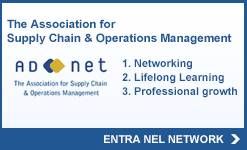Technology Certificate - APICS
E-Learning

DURATA
20 ore

PREZZO
Contattateci per conoscere il costo del corso e per iscrizioni.
Il programma fornisce una panoramica delle più recenti tecnologie della Supply Chain attraverso casi di studio presso multinazionali e società di riferimento di diversi settori. Dopo aver completato il programma, il partecipante avrà acquisito le competenze per:
- migliorare le performance utilizzando le tecnologie più avanzate
- aumentare l'affidabilità e l’efficienza dei processi proponendo nuove soluzioni
- mitigare i rischi informatici e valutare efficacemente i vantaggi e i rischi delle tecnologie emergenti nella Supply Chain
- prendere le giuste decisioni al fine di avere impatti positivi sulle performance E2E della Supply Chain
Con questo programma state-of-the-art, il partecipante esplorerà come la blockchain e altre tecnologie emergenti possono supportare e migliorare i processi e le operations in ambito Supply Chain.
Il programma self paced e-learning comprende 20 ore di formazione e un esame finale all'interno di una piattaforma online interattiva. Il partecipante avrà inoltre accesso a flashcards, video clip, domande di pratica e altro ancora.
Dopo aver superato l'esame, il partecipante riceverà il Supply Chain Technology Certificate di ASCM.
Su richiesta, Advance può pianificare delle Office Hours (della durata di 1,5 ore ogni 2 settimane) con un istruttore certificato che fornirà approfondimenti, spiegazioni e discussioni di casi di studio.

CONTENUTI DEL PROGRAMMA
Blockchain
Come la blockchain può consentire una Supply Chain più trasparente, migliorare la tracciabilità dei prodotti e consentire un archivio digitale di workflow e dei processi.
Advanced Analytics e Automation
Come l'analitica predittiva utilizza machine learning e data mining per prevedere eventi futuri. Capire come l'intelligenza artificiale e la robotica possono essere implementate nella Supply Chain per automatizzare le attività di routine.
Internet of Things
Cosa significa per la Supply Chain e come i digital twins possono aiutare le aziende a prendere decisioni data-driven; come la logistica connessa e la smart production possono snellire le operations, ridurre i costi e accorciare i lead time.
Cybersecurity
Quale è la migliore governance in materia di cybersecurity, tecnologia anti-hacking e controlli di accesso per gestire, valutare, mitigare e monitorare la vostra rete.
Tecnologie di demand planning
Questa sezione tratterà l'affidabilità della tecnologia di previsione nella Supply Chain e il ruolo dell’analisi dei dati e dell’identificazione dei trend per la gestione delle scorte e della produzione.
Additive manufacturing (AM) e stampa 3D
In questa sezione verranno trattatti l’ additive manufacturing e la stampa 3D, il loro utilizzo nella Supply Chain, casi di applicazione oltre a come decidere tra produzione In-house e outsourcing.
Per maggiori dettagli, consultare la sezione PIANO DIDATTICO
-
Piano didattico
LEGGI I DETTAGLI ▾
PROGRAMMA DETTAGLIATO
BLOCKCHAIN
What is Blockchain
- Defining Blockchain
- Why is Blockchain important?
- Key Elements of a Blockchain
- How Blockchain Works
- Blockchain Consensus
Types of Blockchain
- Different Types of Blockchain Networks
- Public Blockchain
- Public versus Private Blockchains
Advantages and Disadvantages of Using Blockchain
- Benefits of Blockchain
- Smart Contracts
- Non-fungible Tokens (NFTs)
- Threats for Blockchain Security
Blockchain Implementation
- Factors to Consider When Implementing Blockchain
- Implementation Steps
Advantages and Disadvantages of Using Blockchain
- How Is Blockchain Used in Supply Chain?
- Case Study:An American Multinational Retail Corporation
- Case Study: PharmaLedger
- Case Study: a Global Leader in Logistics
- Case Study: An American Multinational Automobile Manufacturer
- Case Study: a Swiss Multinational Food and Drink Processing Company
ADVANCE ANALYTICS AND AUTOMATION
What Are Advanced Analytics and Automation?
- Advanced Analytics
- End-to-End Analytics Process
- Automation
- Automation—Robotics
Advanced Analytics Methods
- Operations Research and Management Sciences
- Descriptive, Diagnostic, Prescriptive, Predictive and Cognitive Analytics
- Dashboards
Data Mining
- The Importance of Data and Data Mining
- The Data Mining Process
- Data Mining Tools— Extract, Transform, Load (ETL)
- Data Mining Tools—Relational Databases and SQL
- Data Mining Tools—CRISP-DM
Data Storage and Security
- Data Warehouses
- Cloud Computing
- Data Security
Artificial Intelligence
- Types of Artificial Intelligence
- Machine Learning and Deep Learning
- Supervised and Unsupervised Learning
- Natural Language Processing
Selecting and Implementing New Technology
- Steps to Selecting New Technology
- Total Cost of Ownership
- Implementation Best Practices
- Employee Skills
INTERNET OF THINGS
What Is the Internet of Things?
- Defining IoT
- Evolution of IoT
Visibility and the Need for Track and Trace
- Supply Chain Visibility
- What Is Track and Trace
- Barcoding and QR Codes
- Radio Frequency Identification (RFID)
- Types of RFID
- Not Just “Where Is My Package”—The Importance of IoT
- IoT and Data Regulation
Technology Needed for IoT
- The Cloud
- Data Capture and Translations
- Data Transmission
- Data Access and Actionability
IoT Infrastructure
- What Is an IoT Platform?
- Enablement
- Device and Software Management
- Data Synchronization
- Application Programming Interfaces (APIs)
- Data Streaming
- Event Management
- Accessibility to IoT Data Feeds
- Data Intelligence and Analytics
- Big Data Sets
- Edge Computing
Digital Twins
- What Is a Digital Twin?
- More than Just Sensor Data
- Containerization
- IT/OT Convergence
IOT and Business Segment Applications
- Integration of IoT into Business Sections
- Shop Floor and Field Operations Visibility
- Predictive Maintenance
- Remote and Outsourced Operations
- Retail
Challenges to Implementation
- Financial Impact
- Cybersecurity Data
- Sovereignity
CYBERSECURITY
What Is Cybersecurity?
- Evolution of Cybersecurity
- Cybersecurity Inside the Organization
- Cybersecurity—Who, What, Why, and How?
- Cybersecurity in Supply Chain and Other Business Relationships
Cybersecurity Governance- Why Have Cybersecurity Governance Programs?
- What Should Cybersecurity Governance Programs Look Like?
- Why Do Cybersecurity Governance Programs Fail
Cybersecurity Risk Assessment, Management, and Mitigation- Risk Assessment
- Risk Management
- System-Related Risk Mitigation
- Non-System-Related Risk Mitigation
Enterprise Cybersecurity Education- Employee Training
- IT Education and Cybersecurity Training
- Cybersecurity Risk Training across Supply Chain Partners
Network Access Controls and Monitoring Methodologies- Network Access Control Solutions
- Network Access Control—Employees
- Network Access Control—Suppliers and Business Partners
- Monitoring Methodologies
Redundancy, Firewalls, and Anti-Hacking Technology- Redundancy and Methods to Achieve It
- Firewalls
- Anti-Hacking Technology
DEMAND PLANNING TECHNOLOGIES
The Importance of Demand Planning Technologies in Supply Chain
- What is Demand Planning?
- Demand Planning Technologies
Essential Steps in Forecasting Demand
- Steps in the Forecasting Process
- Determining What to Forecast
- Sources of Data for Forecasting
- A Smartphone Accessory Retail Case Study
Forecasting Methods Used in Supply Chain
- Types of Forecasting Methods
- Judgmental Forecasting Method
- Statistical Forecasting Method
- Combination Forecasting Method
- Choosing the Right Forecasting Method
The Future of Demand Planning
- Elements of Demand Planning
- Why is Demand Planning Important?
- Methods of Demand Planning Using Technology
- Machine Learning (ML) For Better Demand Predictions
- Streamline Forecasting Processes with AI
- Role of IoT in Demand Planning
- Social Media and User-Generated Online Traffic Data
- Time Series Forecasting: Use Cases
- Technology Company Forecasting Problem
- Traditional Planning versus Technology Planning
Reliability of Forecasting
- Sources of Forecasting Errors and How to Reduce Them
- Types of Errors
The Role of Demand Planning in Inventory Control
- How Demand Planning Fits within Inventory Control
- Methods of Inventory Control
- Strategies Used in Production Planning and Scheduling
- Production Environments
ADDITIVE MANUFACTURING (3D PRINTING)
What Is Additive Manufacturing?
- What Is Additive Manufacturing (3D Printing/Rapid Prototyping)?
- The Additive Manufacturing Process
- Hybrid Manufacturing
- Benefits of Additive Manufacturing
Implementing Additive Manufacturing
- Additive Manufacturing—Still an Emerging Technology
- Various Types of Additive Manufacturing
- Materials Used in Additive Manufacturing
Additive Manufacturing and Supply Chain
- Prototypes
- Inventory Implications
- Distributed Manufacturing
- Microfactories
- Portability
- Customization
- Current Uses of Additive Manufacturing
- Vision for Additive Manufacturing in the Future
Challenges of Implementing Additive Manufacturing
- Limitations of 3D Printing Today
- In-house versus Outsourcing
When to Use and When Not to Use 3D Printing
- When Is 3D Printing the Right Choice?
- When Is 3D Printing Not the Right Choice?
- What to Expect in the Future
-
A chi si rivolge
LEGGI I DETTAGLI ▾
- Responsabili della Supply Chain e persone in staff che desiderano migliorare le proprie conoscenze sulle nuove tecnologie
- Responsabili di altre funzioni aziendali e persone in staff
- Plant Manager, Operations Manager e General Manager
- Responsabili IT e Project Manager
- Consulenti ERP
- Consulenti nell'area Supply Chain e Procurement
-
Costi e iscrizione
LEGGI I DETTAGLI ▾
QUOTA DI PARTECIPAZIONE
Contattaci per conoscere il prezzo del corso e per iscrizioni: info@advanceschool.org
Per l’iscrizione occorre inviare via mail a info@advanceschool.org la scheda di iscrizione compilata insieme alla ricevuta dell’avvenuto bonifico o a un ordine d’acquisto.
La scheda può essere scaricata dal link: Scheda iscrizione












